19 Apr Include images of the artworks you’re discussing in your thread. *Length: answer all the questions posed in at least 150 ? 250 words 1. Many of
- Include images of the artworks you're discussing in your thread.
- *Length: answer all the questions posed in at least 150 – 250 words
1. Many of the images in this chapter were used for propaganda purposes. In what ways can art be used in the service of the state and rulers? What is the relationship between art and propaganda? Choose an artwork that you feel fits within this category and address why you would categorize it as propaganda and if it is effective and/or appropriate. You can select works from the text, lecture, or from outside sources that you think will illustrate your opinion (for ex., within the US or Chicago you have personally viewed).
Lecture 13 PPG & Social Activism.html
POLITICS & THE SOCIAL ORDER
Power, Politics, & Glory (PPG)
The PPG theme refers to artworks that support or reinforce the political and social order. Artworks vary from paintings and sculptures to larger architectural structures, such as the White House in D.C., the Empire State Building in NYC, or the ancient Greek Parthenon; each building signifying how society is ordered and enforces political rule. For example, the Washington Mall in D.C. is packed with memorials to notable political leaders, such as George Washington, Thomas Jefferson, Abraham Lincoln, and, finally, in 2011, Martin Luther King, Jr. In addition to the memorials, the DC Mall is lined with national museums of art, space, industry, nature, etc., and each structure glorifies America's story. It's also important to note that the majority of the memorials, political buildings, and museums are in the Neo-Classical style, which mimics ancient Greco-Roman architecture to signify that the U.S. was the new Rome – an unparalleled empire that, unlike Greece & Rome, will never fall.
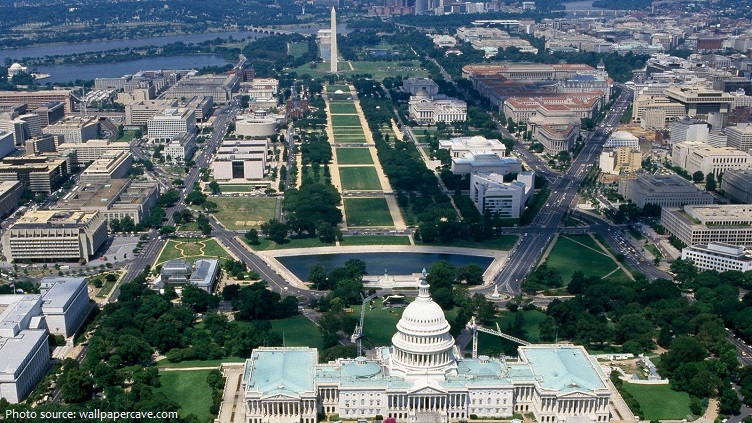
Mount Rushmore, located in Keystone, South Dakota (Gutzon & Lincoln Borglum, 1927-1941) depicts four presidents who were instrumental in the founding, expansion, and unification of the United States of America. George Washington was the first president and led America's defeat and liberation from Great Britain, and marked the beginning of the United States. Thomas Jefferson, the 3rd POTUS, penned the Declaration of Independence and brokered the Louisiana Purchase (1803) that doubled the size of the U.S. (828,000 sq miles). Theodore Roosevelt, the 26th POTUS, was instrumental in the development of the Americas: he outlawed monopolies and advocated for the "common man," he negotiated the construction of the Panama Canal that connected the Atlantic Ocean (eastern U.S.) and the Pacific Ocean (western U.S.), and he established the national parks system. Abraham Lincoln, the 16th POTUS, ended the Civil War by abolishing slavery (which bankrupted the South) thereby preserving the union of the United States. The memorial was carved into one of the most sacred mountains of the Lakota people, Six Grandfathers, which represented Lakota cosmology & belief, was a site of pilgrimage for vision quests and other rites of passage, and symbolized the history and memory of the Lakota. Beyond being a memorial celebrating the history of the United States, it's also a symbol of power over America's indigenous people. Look at the map below. What surrounds the memorial?
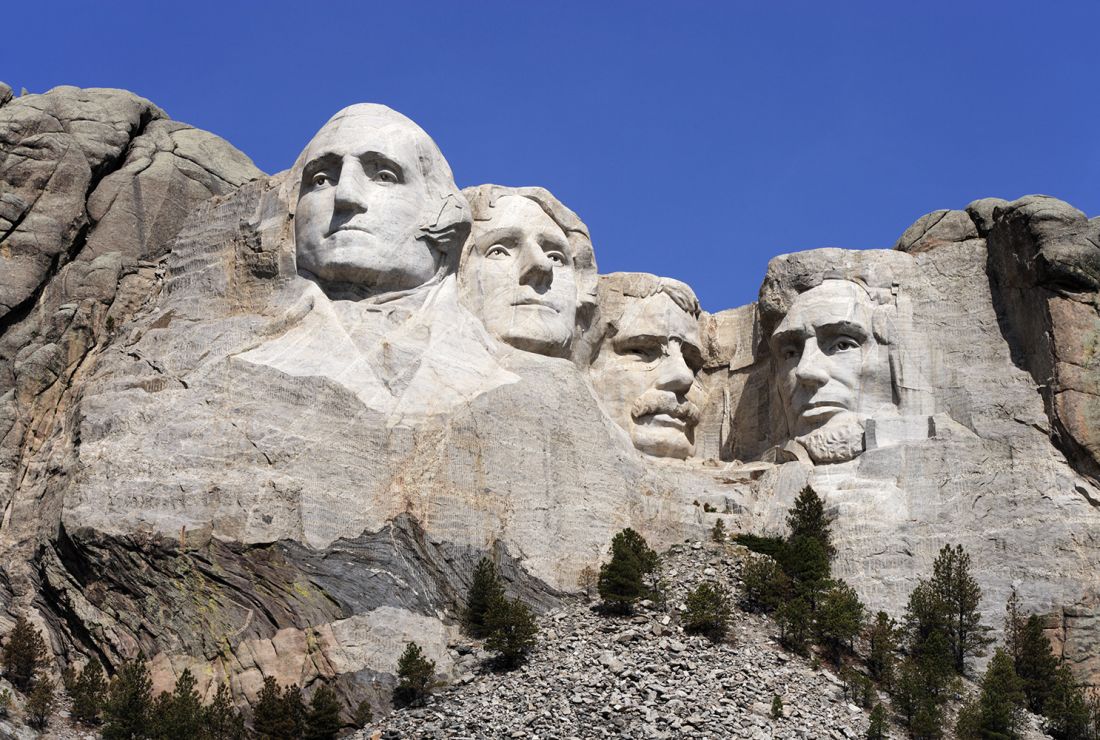
Royal portraiture is another example of PPG such as Hyacinthe Rigaud's full-length portrait of King Louis XIV of France (the Sun King) c. 1701 (Oil on Canvas, 9'1" x 6', Louvre Museum, Paris). King Louis stands in the contrapposto pose and is draped with the blue royal regalia of France covered with gold fleur-de-lis and a bejeweled sword hangs from his left hip. Behind him on the right is the throne which has been de-emphasized by the scale of the king; to his left, a large marbled column with a relief sculpture of Athena/Minerva, the Greek/Roman Goddess of War & Wisdom, is placed just behind his crown; and in the far left background, a marble corridor further references ancient Greece & Rome. The royals were not only political leaders and keepers of social order, but also trendsetters. Louis wears a wig, which was very fashionable, as were wearing tights that showed off his muscular legs (he was very proud of his dancer's legs); in fact, to further accentuate his legs, he began wearing healed shoes to make his calf muscles pop. The portrait displays Louis' power & glory as the king of France, which he also believed was the new Rome & France would never fall.

Divine Right to Rule (DRR)
DRR, aka the Divine Right of Kings, is a sub-category of PPG. Prior to the Enlightenment, most political, religious, and military leaders believed they were either descendant of the gods or chosen by them to lead, and they could not be held accountable for their actions by any earthly group, such as the Roman Senate or British Parliament – they answered only to the Gods. The belief kept social order because of fear of angering the Gods. And, to ensure social order, public artworks, such as Augustus of Primaporta, were created as propaganda to reinforce their God or demi-God status within society.
Augustus of Primaporta, c. 1st century CE, depicts a bare-footed (bare feet = 1. divine status; or 2. savagery) idealized Caesar Augustus (1st Emperor of Rome) in the Ad Locutio pose wearing military regalia. A toga, signifying his political status, is draped around his waist and left arm, and Cupid, the son of Venus, riding a dolphin at his right leg denotes Augustus' divine lineage. On his breast plate, the Gods and Goddesses surround Augustus as he successfully negotiates the return of a military standard from an enemy, which suggests that his diplomacy skills were given to him by the Gods and that the Gods are always at his side.
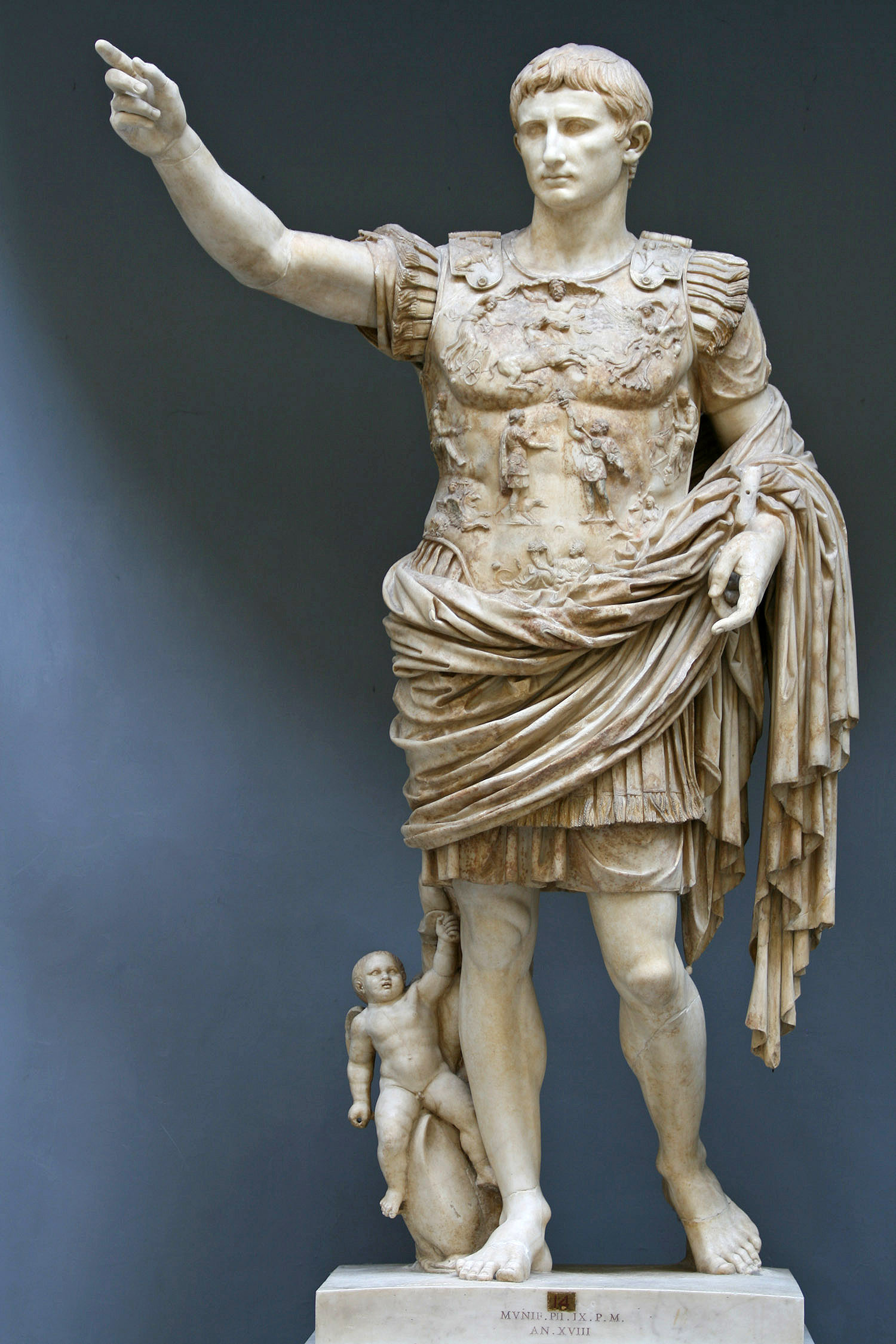
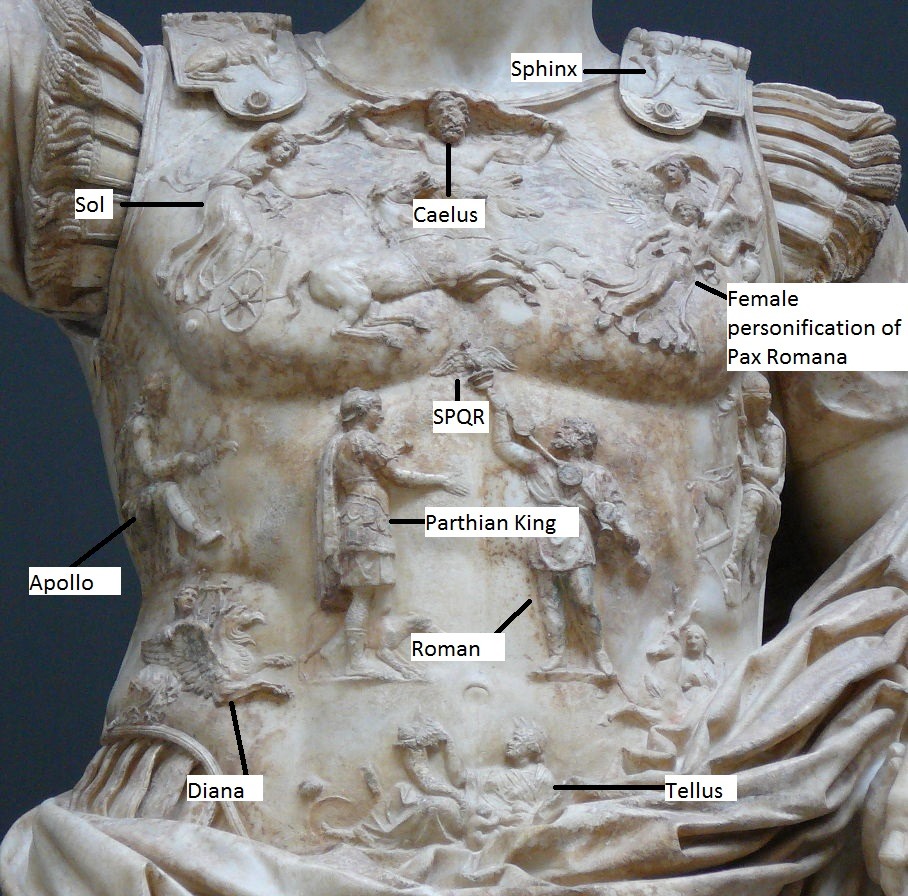
Social Protest, Conflict & Resistance
Artists have a responsibility to record important events in history, such as Diego Velazquez's Surrender at Breda (1634-1635, O/C, 10'1" x 12", Prada Museum, Madrid). Velazquez' painting is an example of political propaganda that affirmed the power of 17th-century Spain.
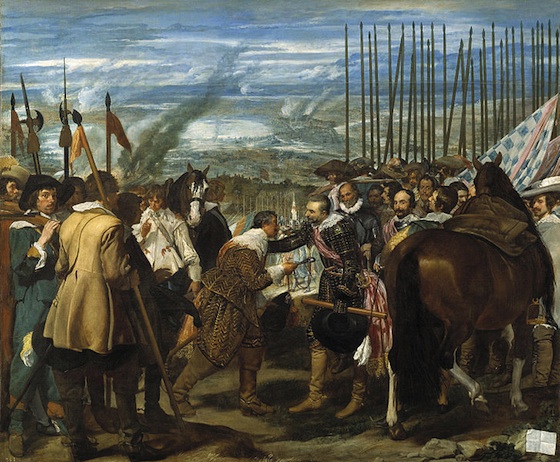
Since the mid-1800s, artists began using their artworks to protest against those in power and to hold them accountable for their actions. In 1937, Pablo Picasso was commissioned to create an artwork for the Spanish Pavilion at the 1937 Paris International Exposition (World's Fair). He painted what is considered by most to be his masterpiece, Guernica – a 25'6" x 11'5" oil on canvas painting that recorded the bombing of Guernica (a small Basque town in Northern Spain) by Nazi Germany & Fascist Italy at the request of Spanish Nationals.

Beginning in the 1950s, U.S. artists also began using their artworks as political protest, sometimes subliminally, against the prevailing power structures that PPG supported. This era is known as post-modernism & we're still living in it. Contemporary artists such as Jasper Johns, Dread Scott, Banksy, Jaune Quick-to-See Smith, Ai Weiwei, Betye Saar, and so many more use their Art to critique the power, politics, and glory that leaders attempt to convey to the general public. Protest artists use their artworks highlight corruption, injustices, oppression, and other forms of socio-political discrimination in society.
Ai Weiwei caught the eye of the Chinese government early in his career when he photographed a 1995 performance when he smashed an ancient Han dynasty urn – an act of political protest (a signature of Weiwei's body of work). His act of destroying a the urn was symbolic of his belief that for China to become a democracy, they need to destroy the current political system. Viewed as an act of dissidence & iconoclasm by his critics, Weiwei responded "General Mao used to tell us that we can only build a new world if we destroy the old one" (The Art Story).

In 2011, American protest artist, Dread Scott, mimicked Weiwei's performance when he burned the U.S. Constitution (Dread Scott, Burning the U.S. Constitution, 2011, 3-series photographic document of performance). He believes that for the U.S. to move forward as a democracy, we need to destroy the constitution, which he adamantly asserts is a racist document written by and for the benefit of wealthy land and slave holders.
Alabama is a state known for its history or racist ideologies & segregation laws, a site of decades of racial violence against African Americans, and the center of many racial protests during the 1960s. In 2008 (the year Obama became the first black U.S. POTUS), UK-based anonymous street artist, Banksy, visited the state's capitol, Montgomery, and left a poignant message to the residents of the city. The work was quickly tagged over.
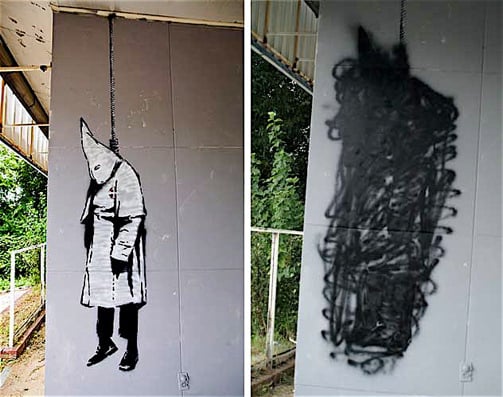
2015 marked the 50th anniversary of the freedom march from Selma, AL to Montgomery and there were many events planned to celebrate the achievement of the Civil Rights Movement that began there. In protest against the celebratory events, The Friends of Forrest, Inc. (a neo-confederate group and Nathan Bedford Forrest (pictured) was a slave trader and first grand wizard of the KKK) erected a billboard at the Edmund Pettus Bridge (Pettus was head of the Alabama KKK). The bridge was the site of "Bloody Sunday" when 600 peaceful demonstrators were brutally attacked as they began their march to Montgomery. Many believe Banksy returned to Montgomery and threw up I Have a Dreamcatcher that depicts MLK, Jr. at the center of a dream catcher with his suit opened like Superman to reveal a red X as if expecting his execution.
 .
. 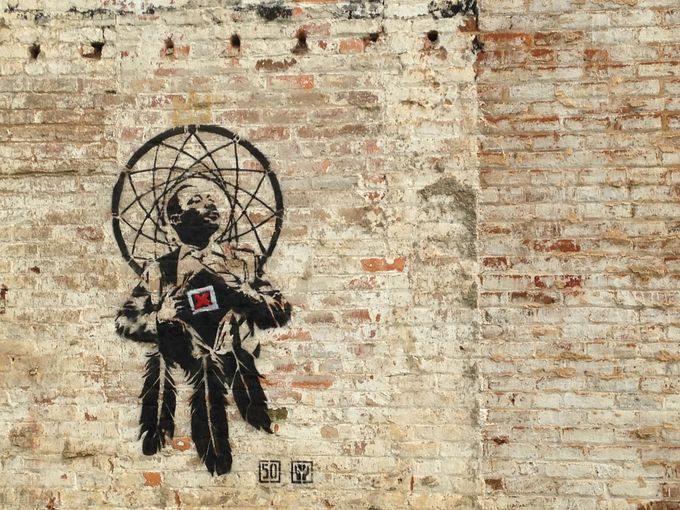
PastedImage_b4ncl0of60e9rqolejm0zunw1qg7qjk10015419422.png
Dread Scott_Burning the U.S. Constitution.jpg
,
Power, Politics, and Glory
Chapter 9
Lazzari/Schlesier, Exploring Art, Revised 5th Edition. © 2020 Cengage. All Rights Reserved. May not be scanned, copied or duplicated, or posted to a publicly accessible website, in whole or in part.
Learning Objectives
Explain the role of art in promoting the power of individual rulers.
Discuss how art has been used for propaganda purposes.
Describe how art can glorify the achievements of a ruler.
Give examples of works of architecture that glorify the state.
Describe how certain objects of prestige play an important role in enhancing the status of a ruler.
Compare various images of war and peace.
Lazzari/Schlesier, Exploring Art, Revised 5th Edition. © 2020 Cengage. All Rights Reserved. May not be scanned, copied or duplicated, or posted to a publicly accessible website, in whole or in part.
Map 5
Map 5 The Expansion of Islam, the Byzantine Empire, and the Migration of Germanic People into Southern Europe.
Lazzari/Schlesier, Exploring Art, Revised 5th Edition. © 2020 Cengage. All Rights Reserved. May not be scanned, copied or duplicated, or posted to a publicly accessible website, in whole or in part.
Figure 9.1
9.1 Imperial Palace, Forbidden City, Beijing.
Lazzari/Schlesier, Exploring Art, Revised 5th Edition. © 2020 Cengage. All Rights Reserved. May not be scanned, copied or duplicated, or posted to a publicly accessible website, in whole or in part.
Figure 9.2
9.2 Yan Liben. Portraits of the Emperors (detail), China, 7th century. Ink and colors on silk, 1' 5 1/2" high.
Lazzari/Schlesier, Exploring Art, Revised 5th Edition. © 2020 Cengage. All Rights Reserved. May not be scanned, copied or duplicated, or posted to a publicly accessible website, in whole or in part.
Figure 9.3
9.3 Menkaure and His Wife, Queen Khamerernebty, Fourth Dynasty, Gizeh, Egypt, c. 2600 BCE. Slate, approximately 4' 6 1/2" high.
Lazzari/Schlesier, Exploring Art, Revised 5th Edition. © 2020 Cengage. All Rights Reserved. May not be scanned, copied or duplicated, or posted to a publicly accessible website, in whole or in part.
THE GLORY OF THE RULER (1 of 2)
Artistic devices are used to glorify a ruler’s image:
idealized image: ruler depicted in flawless, youthful manner, a wise or dignified demeanor
symbols: indicate omnipotence, authority, divine blessing, military or religious power
compositional devices: occupies the center, shown larger than other figures, clothing may attract attention
Lazzari/Schlesier, Exploring Art, Revised 5th Edition. © 2020 Cengage. All Rights Reserved. May not be scanned, copied or duplicated, or posted to a publicly accessible website, in whole or in part.
THE GLORY OF THE RULER (2 of 2)
Divine Rulers, Royalty, and Secular/Religious Leaders
Rulers’ depictions often combines aspects of royalty, religious leaders, and/or the divine.
Menkaure and His Wife, Queen Khamerernebty:
side by side, united by the queen’s embrace
they display the Egyptian ideals of beauty and elevated status
Khamerernebty is as large as Menkaure: pharaonic succession was traced through the female line
Lazzari/Schlesier, Exploring Art, Revised 5th Edition. © 2020 Cengage. All Rights Reserved. May not be scanned, copied or duplicated, or posted to a publicly accessible website, in whole or in part.
Figure 9.4 (1 of 2)
9.4 Emperor Justinian and His Attendants, Church of San Vitale, Ravenna, Italy, c. 547. Mosaic on the north wall of the apse.
Lazzari/Schlesier, Exploring Art, Revised 5th Edition. © 2020 Cengage. All Rights Reserved. May not be scanned, copied or duplicated, or posted to a publicly accessible website, in whole or in part.
Figure 9.4 (2 of 2)
Emperor Justinian and His Attendants:
he occupies the center between clergy and military and state officials
political status: shown through the purple cloak and a jeweled crown
religious status: shown through the golden plate used in liturgy
solar disk behind his head indicates his place in the eternal ideal of kingship
the clergy hold sacred objects: a crucifix, a bejeweled manuscript, an incense burner
a soldier’s shield displays the Chi-Rho, an ancient symbol of Christ
The Emperor dominates the center of the composition, representing his power over the military and the church.
Lazzari/Schlesier, Exploring Art, Revised 5th Edition. © 2020 Cengage. All Rights Reserved. May not be scanned, copied or duplicated, or posted to a publicly accessible website, in whole or in part.
Figure 9.5 (1 of 3)
9.5 Crowned Head of an Oni, Wunmonije Compound, Ife, Nigeria, 12th–15th centuries. Zinc, brass; smaller than life size. Museum of the Ife Antiquities, Ife, Nigeria.
Lazzari/Schlesier, Exploring Art, Revised 5th Edition. © 2020 Cengage. All Rights Reserved. May not be scanned, copied or duplicated, or posted to a publicly accessible website, in whole or in part.
Figure 9.5 (2 of 3)
The delicately detailed portrait of an early African ruler, Crowned Head of an Oni, represents the ruler’s elevated status through:
use of bronze, a precious material
sense of calm and serenity
idealized, beautiful, flowing features
crown, likely a royal insignia
lines on the face indicate scarification or strings of a beaded veil
neck rings similar to those worn by the Yoruba today, fat can indicate prosperity
Lazzari/Schlesier, Exploring Art, Revised 5th Edition. © 2020 Cengage. All Rights Reserved. May not be scanned, copied or duplicated, or posted to a publicly accessible website, in whole or in part.
Figure 9.5 (3 of 3)
To see the range of styles in African art, contrast the Crowned Head of an Oni with the Reliquary Guardian Figure.
Lazzari/Schlesier, Exploring Art, Revised 5th Edition. © 2020 Cengage. All Rights Reserved. May not be scanned, copied or duplicated, or posted to a publicly accessible website, in whole or in part.
Figure 9.6 (1 of 2)
9.6 Jayavarman VII, Bayon style, province of Siemreap, Angkor region, Cambodia, late 12th or early 13th century CE. Sandstone head, 1' 4" × 9" × 1'. Musée des Arts Asiatiques-Guimet, Paris.
Lazzari/Schlesier, Exploring Art, Revised 5th Edition. © 2020 Cengage. All Rights Reserved. May not be scanned, copied or duplicated, or posted to a publicly accessible website, in whole or in part.
Figure 9.6 (2 of 2)
This portrait of the last and most powerful King of the Angkor Empire, Jayavarman VII, and the Khmer people displays his contemplative mysticism after his conversion from Hinduism to Buddhism.
Jayavarman VII repelled invaders, fought rival states, and was known for building projects, including the Temple of Bayon at Angkor Wat.
In this portrait, Jayavarman VII chose to be represented as a mystic.
His turned-down eyes and gentle smile became known in Khmer art.
To sum up, many royal portraits across different cultures use similar attributes to convey elevated status:
idealized face/body
symbolic details
centralized composition
dignified demeanor
Lazzari/Schlesier, Exploring Art, Revised 5th Edition. © 2020 Cengage. All Rights Reserved. May not be scanned, copied or duplicated, or posted to a publicly accessible website, in whole or in part.
Objects of Royalty and Prestige
Hawaiian royal objects were made of materials taboo to others in that society.
Hawaiians considered feathers sacred and connected with the gods, so only royalty could own or wear them.
Colors have symbolic value:
red = royalty
yellow = a prosperous future
Lazzari/Schlesier, Exploring Art, Revised 5th Edition. © 2020 Cengage. All Rights Reserved. May not be scanned, copied or duplicated, or posted to a publicly accessible website, in whole or in part.
Figure 9.7
9.7 Cloak and Feather Hat, Hawaii, 18th century. Museo de America, Madrid.
Lazzari/Schlesier, Exploring Art, Revised 5th Edition. © 2020 Cengage. All Rights Reserved. May not be scanned, copied or duplicated, or posted to a publicly accessible website, in whole or in part.
Figure 9.8 (1 of 2)
9.8 Mesquakie Bear Claw Necklace, Tama, Iowa, USA, c. 1860. Otter pelt, grizzly claws, glass beads, silk ribbon, 1' 4 1/4" × 1' 2 1/4" × 3". Photo archive of the National Museum of the American Indian.
Lazzari/Schlesier, Exploring Art, Revised 5th Edition. © 2020 Cengage. All Rights Reserved. May not be scanned, copied or duplicated, or posted to a publicly accessible website, in whole or in part.
Figure 9.8 (2 of 2)
For the Mesquakie people, grizzly bear claws were signs of high status.
The grizzly’s nails were difficult to acquire and considered a great trophy.
The Mesquakie Bear Claw Necklace represented:
Strength.
tenacity (of the bear).
dignity (of the owner).
Lazzari/Schlesier, Exploring Art, Revised 5th Edition. © 2020 Cengage. All Rights Reserved. May not be scanned, copied or duplicated, or posted to a publicly accessible website, in whole or in part.
Contemporary Political Leaders
Today, almost no rulers consider themselves to be divine, and many are not royalty.
There is a great difference between images that are produced under the ruler’s direction and those over which the ruler has little or no control.
Pictures of contemporary rulers come to us as newspaper, television, or online images.
Lazzari/Schlesier, Exploring Art, Revised 5th Edition. © 2020 Cengage. All Rights Reserved. May not be scanned, copied or duplicated, or posted to a publicly accessible website, in whole or in part.
Figure 9.9 (1 of 2)
9.9 Leni Riefenstahl. Triumph of the Will, Germany, 1934. Film. Kobal Collection.
Lazzari/Schlesier, Exploring Art, Revised 5th Edition. © 2020 Cengage. All Rights Reserved. May not be scanned, copied or duplicated, or posted to a publicly accessible website, in whole or in part.
Figure 9.9 (2 of 2)
In 1934, Adolf Hitler commissioned the film Triumph of the Will to glorify:
his rule.
his military strength.
the Nazi order of Aryan supremacy.
Riefenstahl’s film established Hitler as the first media hero of the modern age.
Riefenstahl’s film affected future political campaigns and laid the foundation for consumer advertising.
Lazzari/Schlesier, Exploring Art, Revised 5th Edition. © 2020 Cengage. All Rights Reserved. May not be scanned, copied or duplicated, or posted to a publicly accessible website, in whole or in part.
THE POWER OF THE STATE
Palaces, government buildings, and monuments make the state and ruler seem powerful.
Palaces
Official residences of kings, emperors, and religious leaders visually represent the state’s power.
Lazzari/Schlesier, Exploring Art, Revised 5th Edition. © 2020 Cengage. All Rights Reserved. May not be scanned, copied or duplicated, or posted to a publicly accessible website, in whole or in part.
Figure 9.10 (1 of 2)
9.10 Lamassu, Khorsabad, Iraq, 720 BCE. Limestone, 14' high.
Lazzari/Schlesier, Exploring Art, Revised 5th Edition. © 2020 Cengage. All Rights Reserved. May not be scanned, copied or duplicated, or posted to a publicly accessible website, in whole or in part.
Figure 9.10 (2 of 2)
The brutal and ruthless Assyrians dominated the Near East for more than 300 years.
Lamassu sculptures guarded the palace gate to terrify and intimidate all who entered.
The winged Lamassu is part lion or bull, with the head of a human being.
The horned crown symbolizes the king’s divine power.
Lazzari/Schlesier, Exploring Art, Revised 5th Edition. © 2020 Cengage. All Rights Reserved. May not be scanned, copied or duplicated, or posted to a publicly accessible website, in whole or in part.
Figure 9.11 (1 of 2)
9.11 Persepolis, general view, Persia (Iran), 559–330 BCE.
Lazzari/Schlesier, Exploring Art, Revised 5th Edition. © 2020 Cengage. All Rights Reserved. May not be scanned, copied or duplicated, or posted to a publicly accessible website, in whole or in part.
Figure 9.11 (2 of 2)
This Persepolis palace complex consisted of many structures, including hypostyle halls.
The palace is a fortified citadel located on a terraced platform.
The windows were made of solid blocks of stone with cutout openings.
Interior spaces were large, wide hypostyle halls.
The Royal Audience Hall was 200 ft. square and 60 ft. high and held up to 10,000 people.
These halls’ one hundred carved columns supported a wood-beamed ceiling.
On top of the columns were elaborate capitals with curving scrolls and foreparts of bulls or lions. Some had human heads.
A grand staircase was covered with images depicting subjects presenting tribute to the king. Stairs were chiseled from stone blocks and fitted into place.
Lazzari/Schlesier, Exploring Art, Revised 5th Edition. © 2020 Cengage. All Rights Reserved. May not be scanned, copied or duplicated, or posted to a publicly accessible website, in whole or in part.
Figure 9.12 (1 of 2)
9.12 Palace at Palenque, Maya, Chiapas, Mexico, 514–784.
Lazzari/Schlesier, Exploring Art, Revised 5th Edition. © 2020 Cengage. All Rights Reserved. May not be scanned, copied or duplicated, or posted to a publicly accessible website, in whole or in part.
Figure 9.12 (2 of 2)
Palenque was the center of one of several successive empires in Central America.
Palenque provided living quarters for the Mayan royalty, a center for religious rites, facilities for astronomical studies, and an administrative precinct.
Several thrones were found here.
The 72 ft. tower added important verticality to the horizontal design.
Large tower windows facing the four cardinal points may have had both astronomical and defensive uses.
Lazzari/Schlesier, Exploring Art, Revised 5th Edition. © 2020 Cengage. All Rights Reserved. May not be scanned, copied or duplicated, or posted to a publicly accessible website, in whole or in part.
Figure 9.13 (1 of 2)
9.13 Imperial Throne Room, in Hall of Supreme Harmony, Forbidden City, Beijing.
Lazzari/Schlesier, Exploring Art, Revised 5th Edition. © 2020 Cengage. All Rights Reserved. May not be scanned, copied or duplicated, or posted to a publicly accessible website, in whole or in part.
Figure 9.13 (2 of 2)
Chinese royal architecture supported the emperor’s claim to be the Son of Heaven, father of the people, and the one who maintained Heaven on Earth.
The Imperial Palace had 9,999 rooms and no commoners were allowed to enter.
The high ceiling is covered with elaborate patterns.
The focus is the throne, framed by columns and elevated on a stepped platform.
Lazzari/Schlesier, Exploring Art, Revised 5th Edition. © 2020 Cengage. All Rights Reserved. May not be scanned, copied or duplicated, or posted to a publicly accessible website, in whole or in part.
Figure 9.14 (1 of 2)
9.14 Jules Hardouin Mansart and Charles le Brun. Hall of Mirrors, Versailles, France, c. 1680.
Lazzari/Schlesier, Exploring Art, Revised 5th Edition. © 2020 Cengage. All Rights Reserved. May not be scanned, copied or duplicated, or posted to a publicly accessible website, in whole or in part.
Figure 9.14 (2 of 2)
Built by Louis XIV, the palace of Versailles was a sign of power and an instrument for maintaining that power.
The Hall of Mirrors is 240 ft. long, ceilings covered with frescoes, embellished with bronze capitals, sparkling candelabra, and jeweled trees, all in the Classical Baroque style.
Lazzari/Schlesier, Exploring Art, Revised 5th Edition. © 2020 Cengage. All Rights Reserved. May not be scanned, copied or duplicated, or posted to a publicly accessible website, in whole or in part.
Figure 9.15 (1 of 2)
9.15 Olowe of Ise. Palace Sculpture, Ikere, Nigeria, 1910–1914. Yoruba. Wood and pigment, 5' × 1' 1 1/4".
Lazzari/Schlesier, Exploring Art, Revised 5th Edition. © 2020 Cengage. All Rights Reserved. May not be scanned, copied or duplicated, or posted to a publicly accessible website, in whole or in part.
Figure 9.15 (2 of 2)
The Palace at Ikere provides another example of artwork that symbolizes kingly power.
Because women are revered for their procreative power, the queen towers over the king as the source of his power.
His crown is topped by a bird, are reproductive symbol for mothers, female ancestors, and deities.
Lazzari/Schlesier, Exploring Art, Revised 5th Edition. © 2020 Cengage. All Rights Reserved. May not be scanned, copied or duplicated, or posted to a publicly accessible website, in whole or in part.
Seats of Government
Social and political pressures help determine which styles of architecture are used in government buildings.
In 1836, the old Houses of Parliament in London burned. A new design was sought that would reinforce England’s desire to create a national identity.
Lazzari/Schlesier, Exploring Art, Revised 5th Edition. © 2020 Cengage. All Rights Reserved. May not be scanned, copied or duplicated, or posted to a publicly accessible website, in whole or in part.
Figure 9.16 (1 of 2)
9.16 Charles Barry and A. W. N. Pugin. Houses of Parliament, London, 1840–1860. 940' long.
Lazzari/Schlesier, Exploring Art, Revised 5th Edition
Our website has a team of professional writers who can help you write any of your homework. They will write your papers from scratch. We also have a team of editors just to make sure all papers are of HIGH QUALITY & PLAGIARISM FREE. To make an Order you only need to click Ask A Question and we will direct you to our Order Page at WriteEdu. Then fill Our Order Form with all your assignment instructions. Select your deadline and pay for your paper. You will get it few hours before your set deadline.
Fill in all the assignment paper details that are required in the order form with the standard information being the page count, deadline, academic level and type of paper. It is advisable to have this information at hand so that you can quickly fill in the necessary information needed in the form for the essay writer to be immediately assigned to your writing project. Make payment for the custom essay order to enable us to assign a suitable writer to your order. Payments are made through Paypal on a secured billing page. Finally, sit back and relax.
Do you need help with this question?
Get assignment help from WriteEdu.com Paper Writing Website and forget about your problems.
WriteEdu provides custom & cheap essay writing 100% original, plagiarism free essays, assignments & dissertations.
With an exceptional team of professional academic experts in a wide range of subjects, we can guarantee you an unrivaled quality of custom-written papers.
Chat with us today! We are always waiting to answer all your questions.

